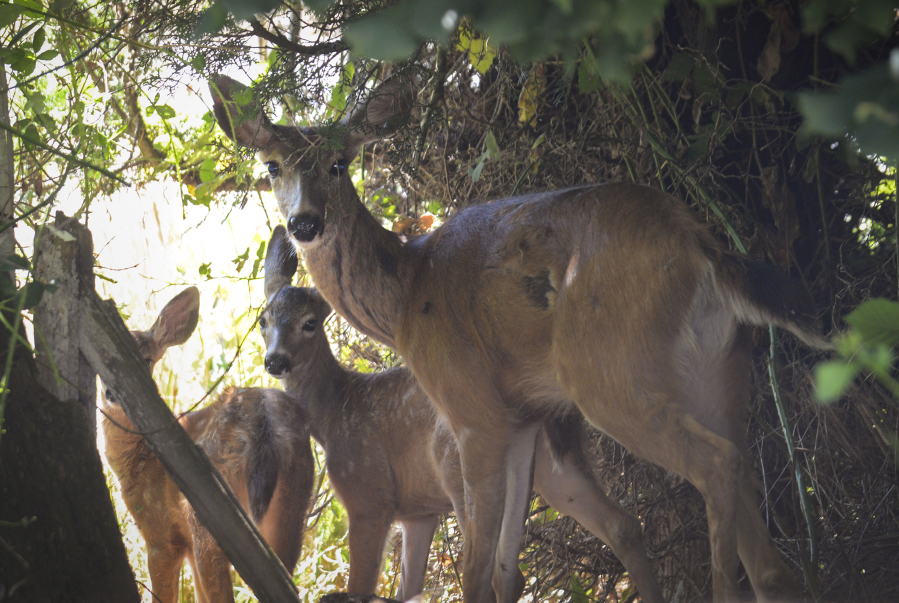FELIDA — A Felida woman said she is worried that a pending development project soon will leave a three-hoofed deer and her two fawns without a home.
For years, Rex Ann Wirkkala has been tending to stray animals on a vacant property near her house in the area of Northwest Lakeshore Avenue and 119th Street. She came upon a deer on the property some time ago and has spent months trying to find a way to help her ahead of the construction.
Part of the doe’s lower, right rear leg is missing, significantly reducing her mobility. Wirkkala, along with the others she has brought to take a look at the deer, agree it doesn’t appear to be an injury, but perhaps some kind of birth defect.
Wirkkala said she doubts the deer and her two fawns will be able to move on without getting struck by a passing car.
“I’ve seen her cross that road before,” she said. “You don’t want to see it. It’s terrible.”
Wirkkala said she found the deer after years of helping tend to the stray cats drawn to the property. She said she has been looking out for stray animals for more than 15 years, going as far as daily visits to Hayden Island in Portland to work with the feral cat population there.
Years ago, while an old woman lived at the home on the now-vacant lot, Wirkkala watched over a feral cat colony that made a home in the barn and briers around the woman’s house, she said. She had the cats spayed or neutered.
The cats slowly died out, the home became unoccupied, and a doe moved into the backyard, she said. Sometime earlier this year, the doe had two fawns.
Wirkkala said the deer seems to spend most, if not all, of her time on the less-than 1-acre lot, which is surrounded by a low fence, briars, hedges and other foliage, leaving it fairly enclosed.
Wirkkala said she believes that a family living on the property after the old woman fed the deer, giving her less reason to leave. She doubts a deer with a bad leg could get as lucky again, she said.
“This is her safe haven,” Wirkkala said. “They say, ‘leave her alone. It’s a deer.’ I get that. I’ve lived out here. I’ve seen many a deer.”
Wirkkala said she regularly checks on the deer, with the blessing of the property owners, who told her they would also like the deer to be safe, she said. She and others have eyed rehabilitation centers and know people who might have some space where the deer can live in peace.
“I want some help for her,” she said, but she’s not sure what to do. “We need help getting her moved to a spot where she can live the rest of her life as a disabled deer.”
The Department of Fish & Wildlife manages the state’s deer population, but she has been unsuccessful in lobbying for the agency’s help, she said.
“We want to do it right … within the law,” she said, and Fish & Wildlife would be most legitimate way to somehow move the deer or to get permission to do it on her own.
Fish & Wildlife will intercede and move animals on occasion, Capt. Murray Schlenker said, but the animals are typically bears or cougars, which don’t adapt well to living in populated areas. And moving the Felida deer and her fawns the agency’s way might do more harm than good.
“Being handled, of course, is traumatic (for a deer),” Schlenker said. “They view us as a danger. While they may be immobilized, they certainly are aware of what’s going on around them.”
The drugs wildlife officials use to knock out an animal for transport can be dangerous, as well.
“But if it’s fully functional, to some degree, and mobile, we don’t put an animal through the trauma of a mobilization, and move it to a location it’s not familiar with and set it free,” he said.
Development displaces a lot of wildlife, he said. While the ramifications of that present a much broader county and state issue beyond just one family of deer, wildlife tends to adapt, he added.
He said he has heard of a bear in Alaska with stumps for front legs that learned to manage. When he worked in Eastern Washington, he kept tabs on a three-legged elk cow for several years, he said, long enough to watch it raise a calf.
“If it’s breeding, it’s a fully functioning animal,” he said of the deer. “If it has twins, it’s doing quite well. … I’m getting the sense this deer is fully able to take care of itself.”
Deer aren’t ones for being herded, but Wirkkala and her friends can get the deer to head west, toward Vancouver Lake once builders come, possibly within the next few weeks, she said. Still, she’s not confident.
“Really, this is not good. She’s telling you, ‘I need something.’ “




